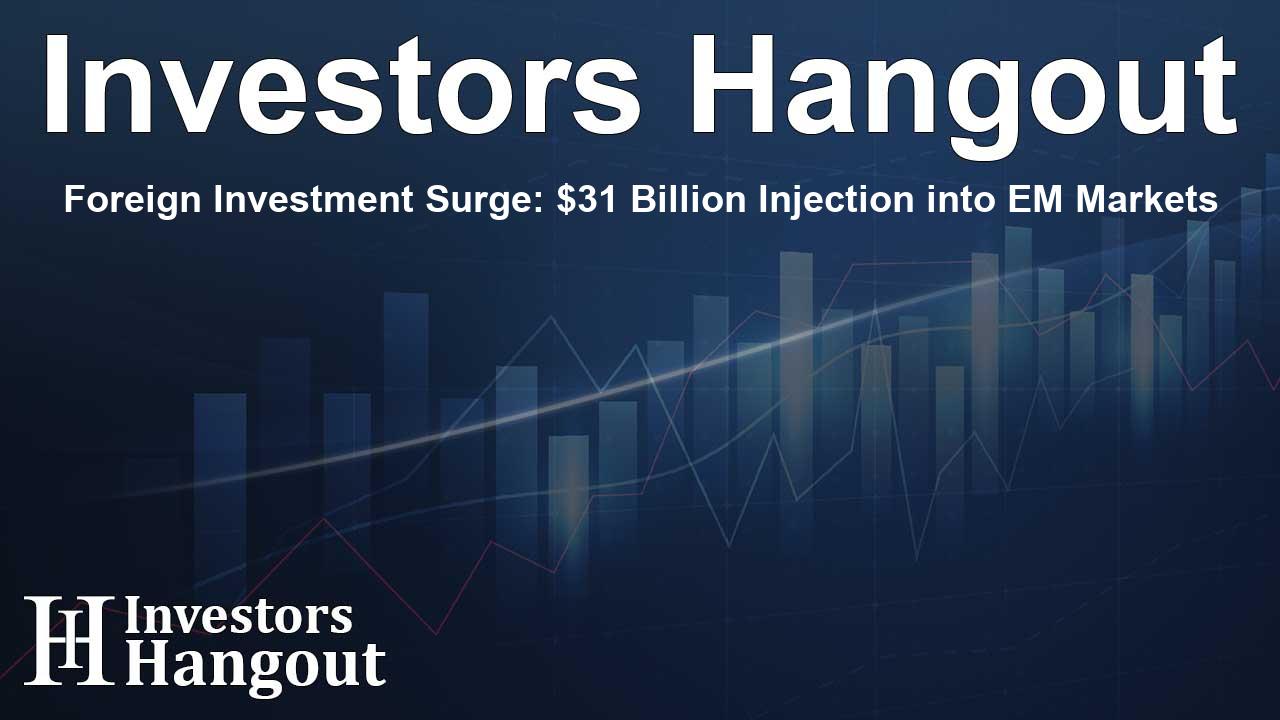Foreign Investment Surge: $31 Billion Injection into EM Markets

Immense Inflows into Emerging Markets
Foreign investors directed an impressive total of nearly $31 billion into emerging market stocks and debt portfolios during August. This influx reflects a strong confidence in the evolving dynamics of these markets, especially with an anticipated shift in U.S. Federal Reserve policies.
Understanding the Shift in Investment Strategies
The surge mainly came from fixed income funds outside of China, generating around $27.8 billion in inflows. Interestingly, there was also a notable allocation of $1.4 billion towards Chinese debt. Conversely, stocks experienced a net inflow of $1.7 billion, despite witnessing an outflow of $1.5 billion from Chinese equities. This active redirection of funds indicates a strategic pivot by investors focusing on emerging markets.
Effects of U.S. Federal Reserve's Rate Decisions
According to Jonathan Fortun, an economist with a banking trade group, the prevailing expectation of imminent rate cuts by the Federal Reserve is not merely speculative; it's largely priced into the market. Investors are proactively adjusting their portfolios to take advantage of the anticipated environment conducive for EM debt. A substantial rate cut could significantly impact capital flows, which reflects the dynamic nature of market sentiments.
Capital Flow Trends
In comparison to the previous months, the monthly net total of $30.9 billion marks a decrease from July's substantial inflow of $37.4 billion, while it shows a stark contrast to the $21 billion outflow experienced a year ago in August 2023. This shift indicates changing sentiments among investors regarding the global economic landscape.
Market Expectations Leading Up to Policy Meetings
With the next policy-setting meeting of the Federal Reserve approaching, there are growing expectations that a rate cut is imminent. The probability of a notable reduction in interest rates is increasingly dominating market speculation, showcasing investor eagerness to reassess their strategies in light of evolving monetary policy.
Regional Investment Patterns
Examining regional inflows provides a clearer picture of where this investment enthusiasm is concentrated. Asia led the charge with a staggering net inflow of $17 billion. Following closely, Latin America received $9.4 billion, while Africa and the Middle East attracted $2.6 billion, and Emerging Europe secured $1.9 billion. This geographic distribution indicates a diverse interest across various emerging markets.
Year-to-Date Trends and Future Outlook
To date, foreign investors have channeled an astounding $186.5 billion into emerging markets, with a noteworthy $162.5 billion specifically directed towards debt. Such figures highlight an ongoing trend where EM portfolios are viewed as increasingly favorable investment avenues. Continuing forward, there exists a potential for a wider interest rate differential between emerging and developed markets, and this could attract even more capital to the emerging sectors. Countries that demonstrate stable economic fundamentals and promising growth trajectories are likely to see increased investor interest.
Frequently Asked Questions
What drove the $31 billion investment into emerging markets in August?
The investment surge is largely attributed to foreign investors positioning themselves for anticipated interest rate cuts by the U.S. Federal Reserve.
How do expectations of Federal Reserve rate cuts impact emerging markets?
Anticipated rate cuts generally create favorable conditions for capital inflows as investors seek higher returns in emerging market assets.
Which regions received the most investments in August?
Asia saw the largest inflow with $17 billion, followed by Latin America with $9.4 billion.
What has been the cumulative investment trend for the year?
Year-to-date, foreign investments in emerging markets have reached approximately $186.5 billion.
How might future rate policies affect investment strategies?
Wider interest rate differentials between emerging and developed markets may incentivize more investment in emerging market assets, especially those with positive economic indicators.
About Investors Hangout
Investors Hangout is a leading online stock forum for financial discussion and learning, offering a wide range of free tools and resources. It draws in traders of all levels, who exchange market knowledge, investigate trading tactics, and keep an eye on industry developments in real time. Featuring financial articles, stock message boards, quotes, charts, company profiles, and live news updates. Through cooperative learning and a wealth of informational resources, it helps users from novices creating their first portfolios to experts honing their techniques. Join Investors Hangout today: https://investorshangout.com/
Disclaimer: The content of this article is solely for general informational purposes only; it does not represent legal, financial, or investment advice. Investors Hangout does not offer financial advice; the author is not a licensed financial advisor. Consult a qualified advisor before making any financial or investment decisions based on this article. The author's interpretation of publicly available data shapes the opinions presented here; as a result, they should not be taken as advice to purchase, sell, or hold any securities mentioned or any other investments. The author does not guarantee the accuracy, completeness, or timeliness of any material, providing it "as is." Information and market conditions may change; past performance is not indicative of future outcomes. If any of the material offered here is inaccurate, please contact us for corrections.